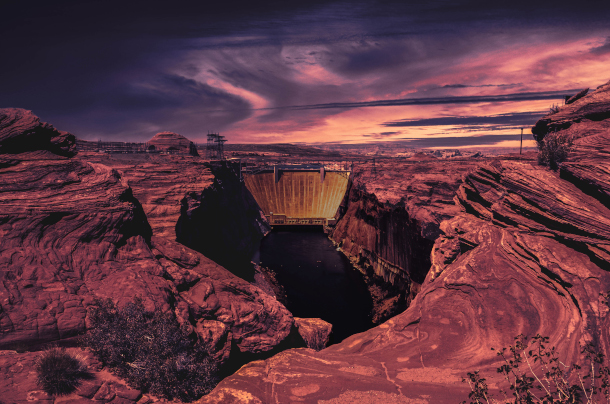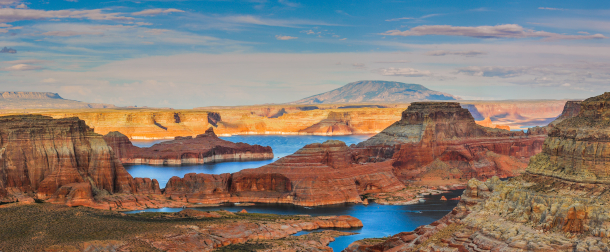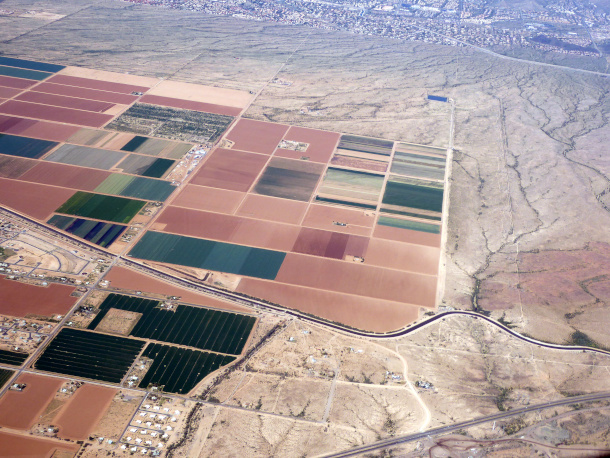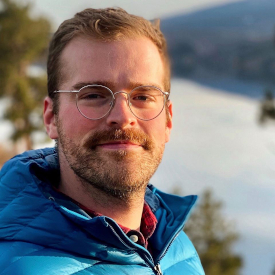Drought Threatens Hydropower
Air Date: Week of May 13, 2022

Glen Canyon Dam forms Lake Powell, one of the largest man-made reservoirs in the United States. (Photo: Udo S, Flickr, CC BY-NC-ND 2.0)
Amid extreme drought and record low water levels in the Colorado Basin, the federal government has decided to retain more water in Lake Powell and release less to Lake Mead and beyond. The action preserves hydropower generation for the short term, but as reporter Luke Runyon explains to Host Steve Curwood, the Colorado River basin still faces a long-term water shortage that imperils the future of cities and farms in the Southwest.
Transcript
BASCOMB: From PRX and the Jennifer and Ted Stanley studios at the University of Massachusetts, Boston this is Living on Earth. I’m Bobby Bascomb.
CURWOOD: And I’m Steve Curwood.
Western water is in trouble, thanks to the rising temperatures of climate change and a record-breaking drought that’s been decades in the making. The extensive water project built nearly a century ago in the Colorado River Basin delivers both water and hydroelectric power to millions of people in the Southwest. And now to keep electric power generation from being cut off the federal government is taking the unprecedented step of holding more water in Lake Powell, behind the Glen Canyon Dam, instead of releasing it to Lake Mead and beyond. Both reservoirs are sitting with record low water levels. For more I’m joined now by Reporter Luke Runyon who covers the Colorado River. Welcome to Living on Earth.
RUNYON: Hey, thanks. Good to be here.
CURWOOD: So how far is it to say this is the first time the federal government is stepped in a big way to say that there are some restrictions now on the flow of the Colorado?
RUNYON: Well, it's not completely unprecedented. The federal government has kind of always played some role in management of the Colorado River. But I think the latest announcements from the federal government are impressive in their scope, and in sort of the precedents that they're setting. And so the decisions that have come out recently, and the proposals from the Biden administration are twofold. One is to restrict the amount of water that would be released from Lake Powell, which is the nation's second largest reservoir on the Colorado River. And the second would be to release a really large volume of water from reservoirs upstream of Lake Powell in order to preserve its hydropower production capacity. And, and really, these are kind of emergency measures that the federal government is taking in order to preserve that hydropower. That's really the sole thing that the federal government is interested in protecting right now. And Lake Powell over the next year still has a possibility of losing hydropower production. So even with these measures, I don't think we're out of the woods when it comes to that.
CURWOOD: Luke remind us of the scale of the Colorado River watershed. Where does the water come from? And how many states in the US and Mexico does it flow across and serve?
RUNYON: Yeah, the Colorado River is a really critical water supply for almost the entire American Southwest. And in the US, its watershed crosses seven states, and that watershed is split into two basins. So you have the upper basin states of Colorado, Wyoming, Utah and New Mexico. And then the lower basin states are Nevada, California and Arizona, the river also crosses over the US Mexico border, and two Mexican states use water from the Colorado River, you also have 30 federally recognized tribes in the basin. So there's a lot of entities, agencies, cities, agriculture, that rely on this water supply. And it's really critical because this area of the country is incredibly dry. And it's a very arid region of the country. And the Colorado River is really the only substantial water supply for for this region.

Lake Powell is holding around 25% of its total capacity in the spring of 2022. (Photo: Zetong Li on Unsplash)
CURWOOD: So let's talk about the major reservoirs, Lake Mead and Lake Powell, as you say, they're kind of running low, just how low are they currently and in comparison to last year?
RUNYON: So the two largest reservoirs in the country are on the Colorado River. And those are Lake Mead outside of Las Vegas, and Lake Powell on the Arizona Utah border. And Lake Powell is currently at 24% of its capacity. Lake Mead is at 30% of its capacity. And both of those reservoirs that's a record low for both of them. And just the other day, Lake Mead dropped low enough that one of the intakes that the city of Las Vegas uses to draw water from Lake Mead was exposed and was sitting above the lake level. And so I think once people start seeing images like that, the concern level and the alarm bells start ringing a little bit harder and louder. And residents of the Southwest, I think are maybe paying more attention to what's going on at those large reservoirs now that we're seeing some of these impacts.
CURWOOD: And so the federal plan talks about an increase there for Lake Powell with I guess, water from the upstream dam, what's going on here and how does this decision affect the hydropower supply stability situation?
RUNYON: Well, as the reservoir declines, it loses the capacity to produce hydropower. And part of it is based on the water pressure. So if you have a really full reservoir, that rush of water through the dam can generate a lot of hydropower. So the capacity for power generation is already diminished. What the concern is now is a total loss of hydropower production at Glen Canyon Dam. And that's something that the federal government with the Bureau of Reclamation was seeing in its models that if actions weren't taken, the reservoir was going to be rapidly approaching a level to where hydropower production would not be possible. It would hit a level where you couldn't send water through those hydropower intake.
CURWOOD: And of course, Lake Mead gets almost all of its water from releases from Powell. So the decision to hold back water at the Glen Canyon Dam will cause it to fall even lower. I mean, what does that do to the water supply? In places like Arizona and Las Vegas?

Arizona farmers typically rely on water from the Colorado River to irrigate crops. (Photo: Yooperann, Flickr, CC BY-NC-ND 2.0)
RUNYON: They're having to have harder discussions about how to rein in their water use. And this is really kind of the crux of the whole problem on the Colorado River right now is, it's always been a story of supply and demand. And what we're seeing is that the supplies keep shrinking. And the demand has not shrank alongside those shrinking supplies. And now it's getting to a point where the reality on the ground shows that if we don't shrink our demands on the Colorado River, we're going to drain these giant reservoirs. And so in states like Arizona, in particular, in Arizona, they're having to have hard discussions about who takes less water from the Colorado River. Under what condition do they take less water? Who has to use less? And when and the the hardest cutbacks really are falling on something called the Central Arizona Project. This is a large, more than 300 mile canal that sneaks its way through the deserts of Arizona to deliver water to Phoenix and Tucson, and to agriculture and tribes in central Arizona.
CURWOOD: Oh, man. I mean, so let's say you're in the agriculture business, you're growing something? How do you get by with less water? Or if you're resident and you want a glass of water? How do you get by with less water?
RUNYON: Those are the hard discussions that are taking place in the Colorado River Basin right now. And in particular, in parts of the lower basin that are going to be taking these really large cutbacks. So say, you're a farmer in central Arizona who relies on this water from the Colorado River that's being cut back, you might switch to groundwater, and start pumping water out of the ground in order to irrigate your crops, you might be investing in irrigation technology that makes your operation more efficient. You might be switching crops, you might be retiring all together and saying I'm not going to stay in agriculture when my water supply is being restricted in this way. And I think you're probably seeing all of those play out in Arizona, right now. You know, when it comes to cities, their focus really is on outdoor water use. And you're starting to see a lot more cities focusing on lawn removal, lawn buyback programs, investing more in that, because in homes and you know, a lot of water can be recycled and reused and put back in rivers. It's not a loss to the system. But when you're watering a lawn, that is a loss, that is water that's not being returned to a stream. And so I think cities are seeing that as a potential bank of water that they can use. It's like start mandating people to take out their lawns. And you're seeing that in cities like Las Vegas,
CURWOOD: Now how has these limits on water affecting the different tribal nations that that rely on the Colorado?
RUNYON: Kind of runs contrary to the overall message in the Colorado River Basin, which is everyone needs to use less water in order for us to survive and to kind of keep the whole region healthy. But on tribal lands, there's a lot of water rights that were never fully realized that are senior, so highly protected old water rights, that tribes were never given the opportunity to use. And I think you're increasingly hearing a call for there to be more use of water on tribal land within the Colorado River Basin. And that seems to be the kind of just thing to do. But it runs slightly contrary to this overall message of we all need to use less water, when really in some pockets, there probably needs to be more water use because the tribes had been denied that in the past.
CURWOOD: What about migration for the ag industry? There are a couple of folks who have suggested that the lower Mississippi River has plenty of water, plenty of bottom land, and even not terribly expensive labor. And these days, they don't have much of a water shortage problem, to put it mildly. If anything, sometimes they get flooded out.

Reporter Luke Runyon covers the Colorado River basin for KUNC and 20+ NPR stations in the southwest. (Photo: Courtesy of Luke Runyon)
RUNYON: Yeah, I mean, it's difficult because in parts of the Colorado River Basin, you can essentially have a year round growing season. So in Yuma Arizona, in the Imperial Valley of California, in those desert climates, you could be growing food almost 12 months out of the year, which is not what you can do in you know other parts of the country where you're restricted by long, cold winters. And the limiting factor is water availability. And so if you know farmers are able to keep irrigating, I mean these areas of the country are intensely farm. So if you're eating a salad in December in New York City, there's a really good chance that lettuce was irrigated with Colorado River water. And so I think sometimes it can be really easy for people in different regions of the country to feel like, oh, this is that region's problem and we don't really have to worry about it. No, our diets would have to change if the Colorado River was not irrigating romaine lettuce in parts of the Desert Southwest. So we're all connected.
CURWOOD: Luke Runyon is a radio reporter who just completed a year of study on a fellowship at the University of Colorado. Luke, thanks so much for taking the time with us and I look forward to hearing you back on the air soon.
RUNYON: Thanks, Steve.
Links
New Yorker | "The Lost Canyon Under Lake Powell"
Previous Living on Earth discussion with reporter Luke Runyon about the Colorado River basin
Living on Earth wants to hear from you!
Living on Earth
62 Calef Highway, Suite 212
Lee, NH 03861
Telephone: 617-287-4121
E-mail: comments@loe.org
Newsletter [Click here]
Donate to Living on Earth!
Living on Earth is an independent media program and relies entirely on contributions from listeners and institutions supporting public service. Please donate now to preserve an independent environmental voice.
NewsletterLiving on Earth offers a weekly delivery of the show's rundown to your mailbox. Sign up for our newsletter today!
 Sailors For The Sea: Be the change you want to sea.
Sailors For The Sea: Be the change you want to sea.
 The Grantham Foundation for the Protection of the Environment: Committed to protecting and improving the health of the global environment.
The Grantham Foundation for the Protection of the Environment: Committed to protecting and improving the health of the global environment.
 Contribute to Living on Earth and receive, as our gift to you, an archival print of one of Mark Seth Lender's extraordinary wildlife photographs. Follow the link to see Mark's current collection of photographs.
Contribute to Living on Earth and receive, as our gift to you, an archival print of one of Mark Seth Lender's extraordinary wildlife photographs. Follow the link to see Mark's current collection of photographs.
 Buy a signed copy of Mark Seth Lender's book Smeagull the Seagull & support Living on Earth
Buy a signed copy of Mark Seth Lender's book Smeagull the Seagull & support Living on Earth

